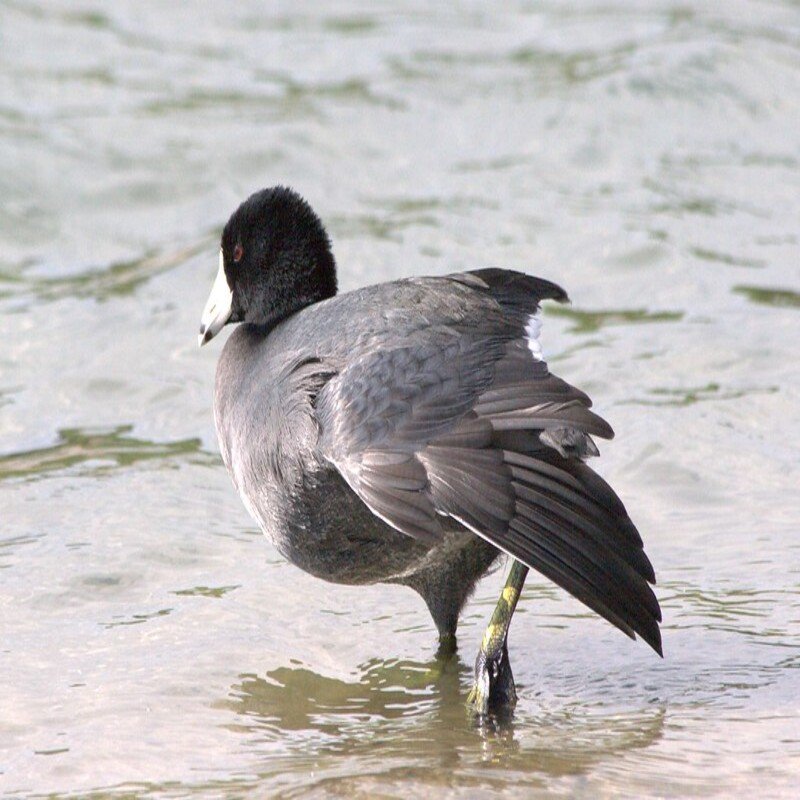The American coot, Fulica americana, alternatively known as the mud hen or pouldeau, is a member of the Rallidae family of birds. Though sometimes confused with ducks, American coots are only distantly related to ducks and are classified as a distinct order. In contrast to ducks, who have webbed feet, coots have broad, lobed scales on their lower legs and toes that fold back with each step to aid in walking on dry land.
Quick Overview: Fulica Americana – American Coot
Body size: Around 15 in (38 cm) and a weight of 726 g (25.6 oz)
Main colors: Gray, Black, White, Red
Range: Throughout the United States
Migratory Bird: Yes
Best time of the year to see in the U.S.: All Year (January – December)
Conservation Status: Least Concern
American Coot Description
A medium-sized, chicken-like swimming bird with a dark gray to black overall coloration, a small, white bill, and white coverts on the undertail. Toes are lobed rather than webbed. The upper border of the frontal shield is red, but only visible up close. Swift direct flight with rapid wing beats, feet protruding beyond the tail.

Size
These birds have a length of 15 in (38 cm) and a weight of 726 g (25.6 oz). Their wings could range from 23-28 in (58-71 cm).
Feeding
American Coot is a species that is omnivorous. It will consume small water animals (fish or tadpoles), insects, and pond vegetation. Coots, like ducks, can dive for food. When they dive, they look for plants that grow on the pond’s bottom. After bringing plants to the surface, coots will pick them apart in search of edible parts. While they are capable of foraging for themselves, it has been observed stealing food from other birds.
Habitat
Coots dwell along waterways, whether they winter in the south or spend the summer in the north. They are freshwater birds that inhabit the shallows of freshwater lakes, ponds, and marshes, but they are infrequently spotted in brackish water. Additionally, they have been discovered living in man-made ponds in parks and golf courses.
Behavior
Fulica americana is a flocking bird species. Coots are the only rail family members who live in groups. They use a variety of noises, from grunting to clucking, to communicate with one another and to ward off predators. A coot splashes twice a year: during mating season to attract attention and to deter predators. The primary predator of coots is the osprey (a kind of hawk). Due to the fact that it is more suited to life on land than other birds, they cannot take flight with a “dead start.”
Fulica Americana Scientific Classification
- Kingdom: Animalia
- Phylum: Chordata
- Subphylum: Chelicerata
- Class: Aves
- Order: Gruiformes
- Family: Rallidae
- Genus: Fulica
- Species: Fulica amaricana
Other common names
They are also known as the mud hen or pouldeau.
Best time of the year to see
In the United States, the best time of year to see these birds is all year round, regardless of the season. This refers to any month of the year between January and December.
Distribution of the American Coot in the USA
Breeds southward from British Columbia, western Canada, and New York. Winters in British Columbia, Kansas, Illinois, and Massachusetts are typical.
The American Coot can be found in the following states in the United States – Alabama, Alaska, Arizona, Arkansas, California, Colorado, Connecticut, Delaware, Florida, Georgia, Hawaii, Idaho, Indiana, Iowa, Kentucky, Louisiana, Maine, Maryland, Michigan, Minnesota, Mississippi, Missouri, Montana, Nebraska, Nevada, New Hampshire, New Jersey, New Mexico, North Carolina, North Dakota, Ohio, Oklahoma, Oregon, Pennsylvania, Rhode Island, South Carolina, South Dakota, Tennessee, Texas, Utah, Vermont, Virginia, Washington, West Virginia, Wisconsin, and Wyoming.
